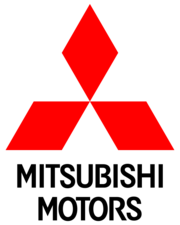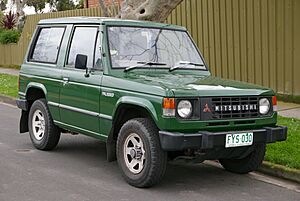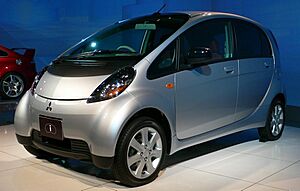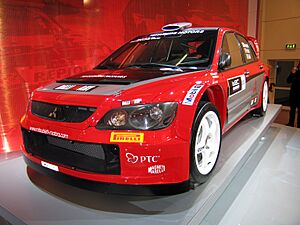Mitsubishi Motors facts for kids
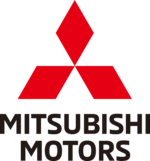 |
|
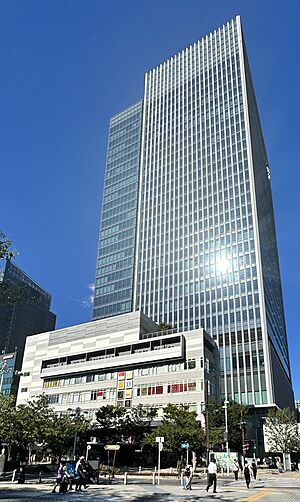
Mitsubishi Motors's headquarters in Shibaura, Minato, Tokyo
|
|
|
Native name
|
三菱自動車工業株式会社
|
|---|---|
|
Romanized name
|
Mitsubishi Jidōsha Kōgyō KK |
| Public | |
| Traded as | TYO: 7211 |
| Industry | Automotive |
| Predecessor | Mitsubishi Heavy Industries Automobile Division |
| Founded | 22 April 1970 |
| Headquarters | Tamachi Station Tower S,
,
Japan
|
|
Area served
|
Worldwide |
|
Key people
|
|
| Products |
|
|
Production output
|
|
| Revenue | |
|
Operating income
|
|
| Total assets | |
| Total equity | |
| Owners |
|
|
Number of employees
|
42,625 (total) 13,829 (non-consolidated) 28,796 (consolidated) (as of 10 November 2022) |
| Subsidiaries |
|
Mitsubishi Motors Corporation is a big Japanese company that makes cars. Its main office is in Minato, Tokyo, Japan. In 2011, Mitsubishi Motors was one of the biggest car makers in Japan and among the top 20 worldwide.
Since October 2016, Nissan has owned a big part of Mitsubishi (34%). This means Mitsubishi is now part of a larger group called the Renault–Nissan–Mitsubishi Alliance. Mitsubishi Motors is also part of the larger Mitsubishi Group, which used to be Japan's biggest industrial group.
The company started in 1970. It was formed from the car-making part of Mitsubishi Heavy Industries. Another company, Mitsubishi Fuso Truck and Bus Corporation, used to be part of Mitsubishi Motors. This company makes trucks and buses. Now, it is owned by a German company called Daimler Truck, but Mitsubishi still owns a small part of it.
Contents
How Mitsubishi Motors Started
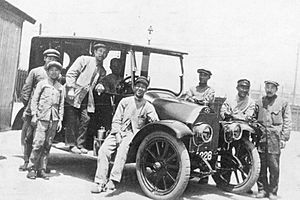
Mitsubishi started making cars way back in 1917. That's when Mitsubishi Shipbuilding Co., Ltd., made the Mitsubishi Model A. This was Japan's first car that was made in a series. It was a seven-seater car built by hand. However, it was very expensive compared to cars made in other countries. Because of this, only 22 were made before they stopped production in 1921.
In 1934, Mitsubishi Shipbuilding joined with Mitsubishi Aircraft Co. The new company was called Mitsubishi Heavy Industries (MHI). It became the largest private company in Japan. MHI focused on making planes, ships, and trains. But in 1937, they made a special car called the Mitsubishi PX33. This car was a test model for military use. It was the first Japanese passenger car with four-wheel drive. This technology became very important for the company many years later.
After World War II
After Second World War, the company started making vehicles again. They resumed making Fuso buses. They also developed a small three-wheeled cargo vehicle called the Mitsubishi Mizushima and a scooter called the Mitsubishi Silver Pigeon.
In 1950, the big industrial groups in Japan were broken up. Mitsubishi Heavy Industries was split into three regional companies. Each of these companies was involved in making cars.
One of these companies, East Japan Heavy-Industries, started bringing in parts for an American car called the Henry J in 1951. Another company, Central Japan Heavy-Industries, made a deal to build Jeep CJ-3Bs under license. These Mitsubishi Jeeps were made until 1998.
By the 1960s, Japan's economy was growing fast. More people wanted to own cars. Central Japan Heavy-Industries, now called Shin Mitsubishi Heavy-Industries, launched the Mitsubishi 500. This was a car for everyone. They followed this with the Minica small car in 1962. In 1963, they introduced the Colt 1000, which was the first of their Colt family cars. In 1964, Mitsubishi made its biggest passenger car, the Mitsubishi Debonair. This was a luxury car mainly for the Japanese market.
The three Mitsubishi companies joined back together as Mitsubishi Heavy Industries in 1964. Within three years, they were making over 75,000 vehicles each year. After the Galant was successfully launched in 1969, the company decided to create a separate business just for cars. So, Mitsubishi Motors Corporation (MMC) was formed on April 22, 1970. It was led by Tomio Kubo.
The famous logo of three red diamonds has been around for almost 100 years longer than Mitsubishi Motors itself. The founder of Mitsubishi, Iwasaki Yatarō, chose it. The name Mitsubishi means "three water caltrops" or "three rhombuses," which you can see in the company's logo.
1970s: Working with Chrysler
Tomio Kubo wanted to sell more cars overseas. So, in 1971, MHI sold a 15% share of the new company to the American car giant Chrysler. Because of this deal, Chrysler started selling the Galant in the United States as the Dodge Colt. This helped Mitsubishi Motors make over 250,000 vehicles a year. In 1977, the Galant was sold as the Chrysler Sigma in Australia.
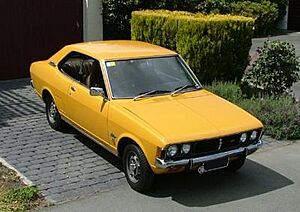
By 1977, Mitsubishi started selling cars directly in Europe. They set up dealerships called "Colt." Their yearly production grew from 500,000 cars in 1973 to 965,000 in 1978. However, Chrysler and Mitsubishi started to have disagreements. Chrysler felt that Mitsubishi was selling cars in markets that Chrysler wanted for its own small cars. Mitsubishi felt that Chrysler was trying to control too many of their decisions.
1980s: Entering the U.S. Market
Mitsubishi Motors made a million cars in 1980. Around this time, Chrysler was having financial problems. To avoid going out of business, Chrysler had to sell its car-making division in Australia to Mitsubishi Motors. The new Japanese owners renamed it Mitsubishi Motors Australia Ltd (MMAL).
In 1982, the Mitsubishi brand was first sold in the American market. Cars like the Mitsubishi Tredia sedan and the Mitsubishi Cordia and Mitsubishi Starion coupés were sold through 70 dealers. There was a limit on how many cars Mitsubishi could send to the U.S. This was part of an agreement between the two countries.
Even with the disagreements, Chrysler and Mitsubishi decided to build cars together in Normal, Illinois. This joint company was called Diamond-Star Motors (DSM). It was named after the logos of both companies: Mitsubishi's three diamonds and Chrysler's pentastar. The factory opened in March 1988 and could make 240,000 vehicles a year. They first made three similar sports cars: the Mitsubishi Eclipse, Eagle Talon, and Plymouth Laser.
By 1989, Mitsubishi was making 1.5 million cars worldwide. In 1988, Mitsubishi Motors became a public company. This meant people could buy shares in the company. Mitsubishi Heavy Industries kept a large share, and Chrysler also increased its ownership. The money raised helped Mitsubishi pay off debts and grow its business in Southeast Asia.
1990s: Focusing on SUVs
In 1989, Hirokazu Nakamura became the president of Mitsubishi Motors. He led the company in new directions. Even though the Japanese economy was facing problems, sales of the new Mitsubishi Pajero were very strong.
In the early 1990s, many car makers in Japan didn't think SUVs would be popular in their country. But Nakamura believed in them and put more money into developing SUVs. His idea worked! Mitsubishi's wide range of four-wheel drive vehicles, from small cars like the Mitsubishi Pajero Mini to passenger vans like the Delica Space Gear, became very popular in Japan. By 1995, Mitsubishi's share of the Japanese market grew to 11.6%.
In 1991, Chrysler sold its share in Diamond-Star Motors to Mitsubishi Motors. The two companies continued to work together on some projects. Chrysler then sold all its remaining shares in Mitsubishi Motors by 1993. After this, Mitsubishi Motors looked for new partners around the world. One important partnership was with Nissan to make small "kei" cars.
2000s: Changes and New Models
In January 2005, Mitsubishi Heavy Industries, Mitsubishi Corporation, and Mitsubishi Tokyo Financial Group helped Mitsubishi Motors with a large financial rescue. This happened after a problem in Japan where Mitsubishi Motors was accused of hiding car defects to avoid recalls.
After not having much money for new projects, the company launched the Mitsubishi i small car in 2006. This was their first new model in over two years. They also released a new Mitsubishi Outlander to compete in the popular SUV market. New versions of the Mitsubishi Lancer and Lancer Evolution came out in 2007 and 2008.
Mitsubishi stopped selling some slower-selling cars in the U.S. market. They also cut 10,000 jobs to save money. To make more cars at their U.S. factory, they started looking for new places to sell the Eclipse and Galant, like Ukraine, the Middle East, and Russia. Mitsubishi Motors also made cars for Nissan and worked with Groupe PSA to make an SUV.
Mitsubishi Motors made a profit again in the third quarter of 2006. They continued to be profitable and sold 1,524,000 cars globally in 2007 and beyond. In January 2011, the company announced plans to introduce eight hybrid and battery-powered cars by 2015.
In March 2015, Mitsubishi Motors started building a new factory in Indonesia. This factory can make 160,000 vehicles each year. In July 2015, Mitsubishi Motors announced it would stop making cars at its Diamond-Star Motors plant in Normal, Illinois, U.S. The plant had not been making many cars for several years. Operations there ended in May 2016. The plant was later sold to an electric vehicle company called Rivian in 2017.
2016–Present: Joining the Alliance
In May 2016, after a fuel-efficiency issue was discovered by Nissan, Nissan started to buy a 34% share in Mitsubishi Motors. This made Nissan the largest owner of Mitsubishi. The goal was to make Mitsubishi Motors a part of the Renault–Nissan–Mitsubishi Alliance. Nissan planned to share car designs and work together on new vehicles with Mitsubishi Motors.
Nissan's purchase of the 34% share in Mitsubishi Motors was completed in October 2016. Carlos Ghosn, who was the chairman of Nissan and Renault, also became chairman of Mitsubishi Motors. He remained chairman until November 2018.
By 2023, Renault Group started providing Mitsubishi cars in Europe. For example, the Renault Clio and Renault Captur were rebadged as the Colt and ASX for Mitsubishi. Mitsubishi Motors plans to stop developing its own car designs for the Japanese market around 2026. Instead, it will use car designs made by its partner Nissan.
Other Partnerships
1974–1984: Colt and Lonsdale
The name Colt has been used a lot in Mitsubishi's history. Today, it refers to a small Mitsubishi car. But it's also the name of Mitsubishi's import company in the United Kingdom, called the Colt Car Company. For the first ten years, Mitsubishi cars in Britain were sold under the "Colt" name instead of "Mitsubishi."
In 1982 and 1983, Mitsubishi tried to sell the Australian-built Chrysler Sigma in the UK as the Lonsdale YD41. This was an attempt to get around import limits. But the new brand was not successful.
1975–2003: Hyundai
The South Korean car maker Hyundai built its first car, the Hyundai Pony, in 1975 using Mitsubishi engines and parts. This car was made for 13 years. Mitsubishi owned up to 10% of Hyundai until 2003.
The 1985 Hyundai Excel was sold in the United States as the Mitsubishi Precis. Also, several Mitsubishi models were rebadged as Hyundai cars. These included the Mitsubishi Chariot (as the Hyundai Santamo) and the Mitsubishi Pajero (as the Hyundai Galloper).
1985–2010: Proton
The Malaysian car maker Proton relied a lot on Mitsubishi Motors at first. In 1985, they put together their first car, the Proton Saga, using mostly Mitsubishi parts. Later models like the Proton Wira and Proton Perdana were based on Mitsubishi designs.
Proton eventually started making its own cars. At its best, Proton controlled 75% of the car market in Malaysia. Mitsubishi ended their partnership in 2005. However, in 2008, Proton and Mitsubishi renewed their agreements. The Proton Inspira was again based on the Mitsubishi Lancer design.
1991–2012: Volvo Cars
Mitsubishi worked with Volvo and the Dutch government in a joint company called NedCar in 1991. This factory started making the Mitsubishi Carisma and the Volvo S40/V40 in 1996. The factory also made the latest Mitsubishi Colt and the Smart Forfour. Production of Mitsubishi Outlanders for Europe was also done here until 2012. Mitsubishi sold the plant to a Dutch company called VDL Groep.
1991–2019: Suzuki
In Indonesia, Mitsubishi sold a small truck called the Mitsubishi Colt T120SS from 1991 to 2019. This truck was based on the Suzuki Carry. In 2005, they also rebadged the Suzuki APV as the Mitsubishi Maven. The Maven was stopped in 2009 because it didn't sell well. The Colt T120SS was stopped in 2019.
In Japan, Mitsubishi rebadged the Suzuki Solio as the Delica D:2 and the Suzuki Every as the Minicab.
1998–2016: Hindustan
The Indian car maker Hindustan had a joint company with Mitsubishi starting in 1998. They made models like the Mitsubishi Pajero Sport until 2016.
1999–2011: Groupe PSA
Mitsubishi Motors worked with the PSA Group (a French car company) since 1999. They worked together on diesel engines. In 2005, they teamed up again to make the Peugeot 4007 and Citroën C-Crosser SUVs. These SUVs were based on Mitsubishi's Mitsubishi Outlander.
They also set up a factory together in Kaluga, Russia, in 2008. This factory made SUVs for the Russian market. They also worked together on electric car technology.
2004–2010: Volkswagen
In Europe, Mitsubishi used diesel engines from the German company Volkswagen for some of its cars, like the Mitsubishi Lancer and Mitsubishi Outlander. After 2010, Mitsubishi started using its own diesel engines.
2010–Present: Nissan, Renault–Nissan–Mitsubishi
In December 2010, Mitsubishi and Nissan agreed to form a joint company to develop small "kei" cars for Japan. This company was later named "NMKV Co., Ltd." In 2016, Nissan found that Mitsubishi's fuel economy numbers were incorrect. This affected 625,000 cars made by NMKV. Because of this, Nissan bought a controlling share in Mitsubishi.
2024–Present: Nissan and Honda Alliance
In July 2024, Mitsubishi Motors and Nissan announced they would work with Honda to develop future electric cars together. In December 2024, Honda officially announced a plan to join with Nissan to become the third largest car company by sales. Mitsubishi Motors, which Nissan partly owns, also agreed to join these talks. In February 2025, the talks ended because Nissan did not want to become a smaller part of Honda. However, Nissan, Honda, and Mitsubishi will continue their partnership for electric cars.
Sales in Japan
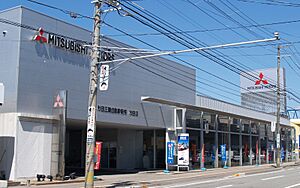
Mitsubishi Motors used to have two different sales channels in Japan, called "Car Plaza" and "Galant Shop." Certain car models were sold only at one type of shop. More recently, these sales channels have been combined into one. Now, all models, including small "kei" cars and commercial vehicles, are sold at the same dealerships.
Past Challenges
Economic Problems in Asia
Mitsubishi Motors had done very well in Southeast Asia. But this changed when there was an economic crisis in the region, starting in 1991. In September 1997, the company closed its factory in Thailand because the country's money lost value and people stopped buying cars. The large truck plant, which had made 8,700 trucks in 1996, was shut down.
Sales in Japan also slowed down a lot in 1997 and 1998. Other Japanese car makers, like Toyota and Honda, made up for slow sales in Japan by selling more cars in the U.S. But Mitsubishi Motors had a smaller share of the American market. So, the problems in Asia affected Mitsubishi Motors more. The company had its worst losses ever in 1997. It also lost its spot as the third-largest car maker in Japan to Mazda.
In November 1997, Mitsubishi Motors hired Katsuhiko Kawasoe as president. He started a plan to cut costs and bring the company back to making a profit by 1998. While this plan had some success, sales were still slow. In 1999, Mitsubishi Motors had to skip paying dividends again.
Vehicle Issues
Mitsubishi Motors had to admit twice that it had hidden problems with its vehicles. This was a very big issue in Japan. Four problems were first made public in 2000. But in 2004, the company admitted to 26 more problems going back to 1977. These included issues with brakes, fuel leaks, and clutches.
This caused big problems for the company. They had to recall over 163,000 cars for free repairs. More recalls by Fuso Truck and Bus brought the total to almost one million vehicles needing repairs. This situation led to the resignation of president Kawasoe and other employees.
"0–0–0" Sales Offer
In the early 2000s, Mitsubishi Motors tried to boost sales in the U.S. by offering a special deal: 0% down payment, 0% interest, and $0 monthly payments for the first 12 months. At first, sales went up a lot. But after the "grace period," many buyers who couldn't afford the cars stopped paying. This left the company with used cars that they hadn't been paid for. This caused big financial losses for Mitsubishi's American credit company. As a result, sales dropped sharply.
End of Australian Production
In October 2005, Mitsubishi Motors Australia launched the Mitsubishi 380 as a replacement for its older car, the Mitsubishi Magna. This was the only car being built at its Australian factory. Even though they invested a lot of money, sales were not as good as expected. After only six months, Mitsubishi cut back production.
On February 5, 2008, Mitsubishi Motors Australia announced it would close its Adelaide factory by the end of March. This meant between 700 and 1,000 direct jobs would be lost.
End of Western European Production
Because of slow sales and financial losses in Europe, Mitsubishi Motors decided to stop making cars in Western Europe by the end of 2012. On October 1, 2012, they announced that a Dutch company, VDL Groep, had taken over the NedCar factory from Mitsubishi Motors.
End of North American Production
In 1988, Mitsubishi Motors opened a factory in the United States in Normal, Illinois. This factory was called Diamond-Star Motors. It was first a joint project with Chrysler. But Chrysler sold its share to Mitsubishi in 1993. After 1995, the factory was known as Mitsubishi Motors Manufacturing America (MMMA).
At its busiest in 2000, the factory made over 222,000 vehicles each year. But as Mitsubishi Motors' sales in North America went down, the factory made fewer and fewer cars. In July 2015, Mitsubishi Motors announced it would close the plant by November. Production at the plant ended on November 30, 2015. Most employees lost their jobs. The plant closed permanently in May 2016.
Leaving the UK Market
Mitsubishi Motors announced that it would leave the UK market by autumn 2021 due to financial reasons. Now, Mitsubishi's presence in Britain is only for after-sales service.
Leaving the Chinese Market
In October 2023, Mitsubishi Motors announced it was leaving its joint company GAC Mitsubishi in the Chinese market. As part of this, another company, GAC Group, took over the factory to make electric vehicles.
Mitsubishi also announced on July 22, 2025, that it was leaving its engine manufacturing joint company in China. Mitsubishi said this was because the Chinese car industry is quickly moving to electric vehicles. This marks the company's complete exit from the Chinese market.
Fuel Economy Issue
In early 2016, Mitsubishi Motors' partner Nissan found differences in fuel consumption numbers for new small cars they were working on together. Mitsubishi Motors made these small cars for Nissan. Mitsubishi Motors admitted that they had been giving incorrect information on fuel use since 2002. They used testing methods that did not follow Japanese rules for 25 years.
Mitsubishi Motors management said they didn't know about the problem. They ordered an investigation by people not connected to the company. This issue led to Nissan buying a controlling share in Mitsubishi Motors in May 2016. Nissan agreed to invest a large amount of money for a 34% ownership stake.
As a result, other Mitsubishi group companies had their ownership in Mitsubishi Motors decrease. Mitsubishi Motors North America stated that cars sold in the United States from 2013 had correct fuel economy information and were not affected.
In May 2016, Mitsubishi Motors announced that Tetsuro Aikawa would step down as president. Both Mitsubishi Motors and Aikawa said that top management was not aware of the mileage issue.
Leadership
- Yuji Sato (1970–1973)
- Tomio Kubo (1973–1979)
- Yoshitoshi Sone (1979–1981)
- Masao Suzuki (1981–1983)
- Toyoo Tate (1983–1989)
- Hirokazu Nakamura (1989–1995)
- Nobuhisa Tsukamura (1995–1996)
- Takemune Kimura (1996–1997)
- Katsuhiko Kawasoe (1997–2000)
- Takashi Sonobe (2000–2002)
- Rolf Eckrodt (2002–2004)
- Yoichiro Okazaki (2004)
- Hideyasu Tagaya (2004–2005)
- Osamu Masuko (2005–2020)
- Takao Kato (2020–present)
Electric Cars
Mitsubishi Motors started selling its i MiEV, an all-electric small car, to customers in the summer of 2009. This was a year earlier than planned. The car has a lithium-ion battery pack under its floor. The company also announced plans to offer five other electric-powered vehicles.
Motorsport and Racing
Mitsubishi Motors has been involved in international motorsport for almost 50 years. They started with street races in the early 1960s. The company then became very good at off-road racing. They were very successful in endurance rallies in the 1970s and the Dakar Rally from the 1980s. They also did well in the World Rally Championship in the 1990s. Ralliart was Mitsubishi's racing part, but the company stopped competing officially in 2010.
Circuit Racing
Mitsubishi Motors first raced in touring car racing in 1962. They entered their Mitsubishi 500 Super DeLuxe in the Macau Grand Prix. This was to help sell their first car made after the war. The small car won the top four places in its category. The company returned the next year with their new Mitsubishi Colt 600 and won the top three places. In 1966, Mitsubishi won the top three places in the "750–1000 cc" class of the 1964 Japanese Grand Prix with the Colt 1000.
The company then focused on "formula car" races from 1966. They won in 1967 and 1968, and reached the podium in 1969 and 1970. They finished strong with a first and second place in the 1971 Japan GP.
Off-Road Racing
The East African Safari Rally was one of the toughest races in the World Rally Championship in the 1970s. Mitsubishi made the Lancer 1600 GSR especially for this long race. They won on their first try in 1974. Their best moment was winning the top three places in 1976. They also won the top four places in the 1973 Southern Cross Rally.
In the 1980s, Mitsubishi continued to race in the WRC with cars like the Lancer EX2000 Turbo and the Mitsubishi Starion. They then won their first big victories with a Mitsubishi Galant VR-4 in the late 1980s. Mitsubishi then made the Lancer Evolution. With driver Tommi Mäkinen, who won the drivers' title for four years in a row (1996–1999), they won the manufacturers' championship in 1998. They have won 34 WRC events since 1973.
Mitsubishi Motors is also the most successful car maker in the history of the Dakar Rally. Mitsubishi first entered in 1983 with their new Pajero. They won in 1992, 1993, 1997, 1998, and from 2001 to 2007. This was an amazing seven wins in a row and 12 wins overall.
Partnership with Jackie Chan
Mitsubishi Motors has worked with actor Jackie Chan for 30 years. He has used their cars in almost all of his movies. The Jackie Chan Cup is an annual celebrity car race that started in 1984. It involves international journalists and stars from Asia racing Mitsubishis. In September 2005, Ralliart, Mitsubishi's motorsport part, made 50 special Jackie Chan Edition versions of the Mitsubishi Lancer Evo IX. Jackie Chan is the honorary director of Team Ralliart China.
Locations Around the World
| Top 10 Mitsubishi Motors vehicle sales by country, 2018 |
||
|---|---|---|
| Rank | Location | Vehicle sales |
| 1 | 146,805 | |
| 2 | 139,856 | |
| 3 | 118,075 | |
| 4 | 104,611 | |
| 5 | 84,826 | |
| 6 | 84,560 | |
| 7 | 65,894 | |
| 8 | 52,196 | |
| 9 | 45,391 | |
| 10 | 30,952 | |
Mitsubishi Motors has factories in Japan, the Philippines, Thailand, and Indonesia. It also has 12 plants that it co-owns with other companies. In Brazil, it has an agreement with a local group to make cars. The company also has three engine and transmission factories. It has five research and development centers. Mitsubishi vehicles are made, put together, or sold in more than 160 countries worldwide.
Research, Design, and Offices
Japan
- Minato, Tokyo: Main Office and Tokyo Design Studio
- Okazaki, Aichi: Car Research & Development Center
- Uzumasa, Ukyō, Kyoto: Car Research and Development Center
- Hokkaido: Car Research & Development Center, Tokachi Proving Ground
- Mitsubishi Auto Gallery (三菱オートギャラリー), 1, Nakashinkiri, Okazaki
Worldwide
- Trebur, Hessen, Germany: Mitsubishi Motor R&D of Europe GmbH (MRDE)
- Ann Arbor, Michigan, United States: Mitsubishi Motors R&D of America, Inc. (MRDA) Head Office
- Cypress, California, United States: Mitsubishi Motors R&D of America, Inc. (MRDA) Research and Design Center
Car Production Factories
Japan
- Okazaki, Aichi: Okazaki Plant (used to be Nagoya Plant)
- Kurashiki, Okayama: Mizushima Vehicle & Powertrain Plant
- Uzumasa, Ukyō, Kyoto: Powertrain plant
- Koka, Shiga: Powertrain plant
Worldwide
- Santa Rosa, Laguna, Philippines: Mitsubishi Motors Philippines Corp. (MMPC)
- Calamba, Laguna, Philippines: Asian Transmission Corp. (ATC)
- Laem Chabang, Thailand: Mitsubishi Motors (Thailand) Co., Ltd. (MMTh)
- Laem Chabang, Thailand: MMTh Engine Co., Ltd. (MEC)
- Cikarang, West Java, Indonesia: PT Mitsubishi Motors Krama Yudha Indonesia (MMKI)
- Di An, Binh Duong Province, Vietnam: Mitsubishi Motors Vietnam Co., Ltd. (MMV)
- Catalão, Brazil: MMC Automotores do Brasil Ltda
Former Production Factories
- Sakahogi, Gifu: Pajero Manufacturing Co., Ltd. Closed in 2021.
- Ooe, Nagoya: Vehicle production plant closed in 2001. It was later sold to Mitsubishi Heavy Industries.
- China: South East (Fujian) Motor Co., Ltd. (SEM). Mitsubishi sold its share in 2021.
- Tonsley Park, South Australia, Australia (1981–2008)
- Tanjung Priok, Jakarta, Indonesia: PT. Krama Yudha Kesuma Motor (KKM), 1981–2005.
- Born, Netherlands: Netherlands Car B.V. (NedCar), shares sold in 2012 to VDL Groep.
- Normal, Illinois, United States: Mitsubishi Motors North America, Inc (MMNA). Opened in 1988, closed in 2015. Sold to Rivian in 2017.
- China: GAC Mitsubishi Motors Co., Ltd. (GMMC)
- Barcelona, Anzoátegui, Venezuela: (MMC Automotriz S.A.) Opened in 1990, sold in 2015.
- Kaluga, Russia: Peugeot Citroën Mitsubishi Automotiv Rus (PCMA Rus), stopped production in April 2022.
See also
 In Spanish: Mitsubishi Motors para niños
In Spanish: Mitsubishi Motors para niños
- Urawa Red Diamonds
- Mitsubishi Motors Mizushima F.C.
- Automotive industry in Japan



